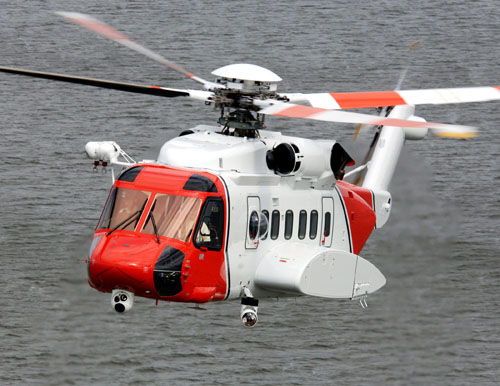The Canadian military is moving ahead with plans to upgrade its Cormorant search-and-rescue helicopter fleet and will also examine whether to buy or lease more of the same aircraft.
The federal government notified industry Thursday morning of the sole source deal to modernize the 14 helicopters. There was no cost attached to the plan but a previous estimate on the upgrade put the price-tag anywhere between $500 million to $1.5 billion.
 |
| A Search and Rescue Technician is hoisted down from a CH-149 Cormorant helicopter over a confined area in Cloud Lake, NS during a training flight on January 8, 2016. Photo: Master Corporal Johanie Maheu, 14 Wing Imaging GD2016-0039-33 ~ Un technicien en recherche et sauvetage est descendu par treuil depuis un hélicoptère CH-149 Cormorant au dessus d’une zone restreinte, à Cloud Lake, en N. É., lors d’un vol d’entraînement, le 8 janvier 2016. Photo : Caporal chef Johanie Maheu, Services d’imagerie de la 14e Escadre GD2016-0039-33 |
Last year Defence Minister Harjit Sajjan suggested that the upgrade program for the Cormorants would be a key program for the Royal Canadian Air Force in the future.
The government will also examine a number of options to expand the search-and-rescue helicopter fleet. Those will include leasing AW-101 helicopters, a variant of the Cormorant, buying AW-101s or upgrading former U.S. presidential helicopters so they can join the search-and-rescue flight line.
Canada purchased the nine VH-71 presidential helicopters, which are similar to the Cormorant, as well as 800,000 spare parts in 2012 after then U.S. President Barack Obama shut down the multi-billion dollar program and decided that existing aircraft were good enough for his needs.
The Department of National Defence stated at the time of the purchase that the VH-71 helicopters would not be put into service but instead stripped down for parts to supply the Cormorant fleet.
Although Canada is entering into a sole-source deal with Leonardo, the government is considering holding a competition among other companies to provide in-service support for the helicopters, according to Department of National Defence officials.
The modernization project comes as the U.S. helicopter firm Sikorsky was trying to interest Canada in buying its S-92 choppers for search and rescue. The S-92 is a civilian version of the Cyclone maritime helicopter the RCAF is putting into service. Sikorsky officials have argued that buying new S-92s would cost less than upgrading the older Cormorants.
 |
| A Sikorsky S-92 in Coast Guard Colours. The Irish Coast Guard currently operates the S-92. The RCN operates the CH-148 Cyclone - the military version of the S-92. |
Department of National Defence sources, however, say it was determined that it was more cost effective to stay with the Cormorant fleet as it is a proven aircraft the RCAF knows well. In addition, existing infrastructure can continue to be used.
The RCAF also hopes to purchase a simulator for the Cormorant fleet to help train crews.
The upgrade program is expected to include the latest avionic and mission systems, advanced radars and sensors, vision enhancement and tracking systems. The CH-149 Cormorant fleet entered service in the year 2000 and the modernization would allow the helicopters to operate for another 25 years at least.
Canada originally bought 15 Cormorants, but one crashed in 2006.
Powered by three engines, the Cormorants are known for their long-range capability, large cargo space and rear-ramp. The helicopter can carry up to 12 stretchers, according to the RCAF.
The decision to sole-source the deal appears to have caught some in the air force off guard. On April 20, the RCAF spokesman Maj. Scott Spurr claimed the air force was still examining options on how to proceed and that the next phase of the project wouldn’t come until 2019.
Defence sources say some inside the RCAF have argued that since seven of the nine U.S. presidential helicopters are already airworthy, it makes sense to use them. Preparing those helicopters for search-and-rescue duty would include installing a side door as well as upgrading the cockpits.
Parts obtained in the U.S. presidential helicopter deal have also played a critical role in keeping the RCAF Cormorants flying, according to documents obtained by Postmedia through the Access to Information law. The U.S. helicopters and spare parts were originally purchased for $168 million.
The RCAF also hopes to purchase a simulator for the Cormorant fleet to help train crews.
The upgrade program is expected to include the latest avionic and mission systems, advanced radars and sensors, vision enhancement and tracking systems. The CH-149 Cormorant fleet entered service in the year 2000 and the modernization would allow the helicopters to operate for another 25 years at least.
Canada originally bought 15 Cormorants, but one crashed in 2006.
Powered by three engines, the Cormorants are known for their long-range capability, large cargo space and rear-ramp. The helicopter can carry up to 12 stretchers, according to the RCAF.
The decision to sole-source the deal appears to have caught some in the air force off guard. On April 20, the RCAF spokesman Maj. Scott Spurr claimed the air force was still examining options on how to proceed and that the next phase of the project wouldn’t come until 2019.
Defence sources say some inside the RCAF have argued that since seven of the nine U.S. presidential helicopters are already airworthy, it makes sense to use them. Preparing those helicopters for search-and-rescue duty would include installing a side door as well as upgrading the cockpits.
Parts obtained in the U.S. presidential helicopter deal have also played a critical role in keeping the RCAF Cormorants flying, according to documents obtained by Postmedia through the Access to Information law. The U.S. helicopters and spare parts were originally purchased for $168 million.
No comments:
Post a Comment